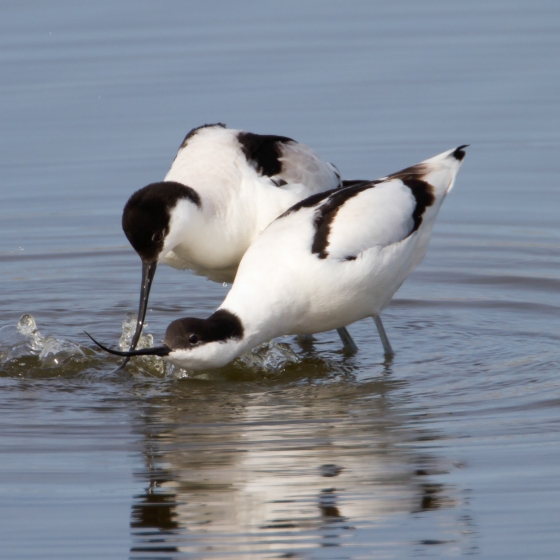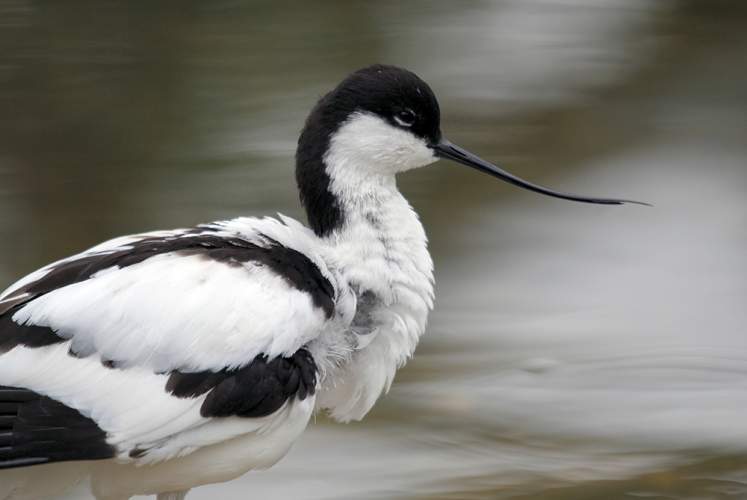Avocet
Recurvirostra avosetta (Linnaeus, 1758)
AV
 AVOCE
AVOCE  4560
4560

Family: Charadriiformes > Recurvirostridae

The Avocet is a long-legged wading bird with striking pied plumage and a long, thin upturned bill.
Re-establishing itself as a British breeding species in 1947 on the Suffolk coast, Avocets now breed more widely around England's east coast. In winter the population is augmented by birds from Europe. Large flocks can be found in suitable coastal habitat, predominantly in the south-east and south-west of England.
Although still predominantly a coastal breeder, atlas data reveal an increasing number of inland breeding locations. However, coastal freshwater marshes are where Avocets are seen at their best. Elegant bluish-grey legs enable a purposeful gait as they sweep their bill from side to side in shallow water to sift tiny invertebrates from the mud.
Identification
Avocet identification is usually straightforward.
SONGS AND CALLS
Listen to example recordings of the main vocalisations of Avocet, provided by xeno-canto contributors.
Alarm call
Call
Develop your bird ID skills with our training courses
Our interactive online courses are a great way to develop your bird identification skills, whether you're new to the hobby or a competent birder looking to hone your abilities.
Browse training coursesStatus and Trends
Population size and trends and patterns of distribution based on BTO surveys and atlases with data collected by BTO volunteers.
CONSERVATION STATUS
This species can be found on the following statutory and conservation listings and schedules.
POPULATION CHANGE
Avocets have since substantially increased both their population (Eaton et al. 2021) and their range (Balmer et al. 2013) during the second half of the twentieth century and subsequently. They are now breeding in suitable wetland locations scattered across most of England and also in Wales, predominantly at coastal sites, and have recently even bred in the Outer Hebrides (Eaton et al. 2021). The five-year mean for the period 2015–2019 reported by the RBBP was 2,138 pairs, an increase of more than 300% in the 25 years to 2019 (Eaton et al. 2021).
| UK winter population |
+234% increase (1996/97–2021/22)  |
DISTRIBUTION
The Avocet's breeding distribution is centred in eastern and southeast England but over recent decades has spread westwards and northwards. By 2008–11 there was one pair in Wales and several pairs in northwest England with the most northerly breeding site in Northumberland. Since then Avocets have continued to spread north, breeding in Scotland for the first time in 2018. In winter the largest concentrations lie around the Thames and Medway Estuaries, on the Suffolk coast and along the south coast between the Solent and Poole Harbour.
Occupied 10-km squares in UK
| No. occupied in breeding season | 141 |
| % occupied in breeding season | 4.7 |
| No. occupied in winter | 153 |
| % occupied in winter | 5.1 |
European Distribution Map
DISTRIBUTION CHANGE
Change in occupied 10-km squares in the UK
| % change in range in breeding season (1968–72 to 2008–11) | +1662.5% |
| % change in range in winter (1981–84 to 2007–11) | +184.3% |
SEASONALITY
Avocets are recorded throughout the year but encountered more widely in spring and summer when birds move away from localised wintering sites to dispersed breeding locations.

Movement
Information about movement and migration based on online bird portals (e.g. BirdTrack), Ringing schemes and tracking studies.
RINGING RECOVERIES
View a summary of recoveries in the Online Ringing Report.
Foreign locations of birds ringed or recovered in Britain & Ireland

Biology
Lifecycle and body size information about Avocet, including statistics on nesting, eggs and lifespan based on BTO ringing and nest recording data.
SURVIVAL & LONGEVITY
View number ringed each year in the Online Ringing Report
Maximum Age from Ringing 
|
24 years 8 months 21 days (set in 2015) 
|
Typical Lifespan 
|
6 years with breeding typically at 2 year |
Adult Survival 
|
0.78±0.05  
|
Juvenile Survival 
|
0.41 (in first year) 
|
CODES & CLASSIFICATION
Ring size 
|
E |
Field Codes 
|
2-letter: AV | 5-letter code: AVOCE | Euring: 4560 |
For information in another language (where available) click on a linked name
Research
Interpretation and scientific publications about Avocet from BTO scientists.
CAUSES AND SOLUTIONS
Causes of change
A study in Germany found that predation by foxes and flooding affected hatching success and that June temperatures were the main determinant of chick survival, which was the main factor influencing breeding productivity (Hötker & Segebade 2000). This might suggest climate change as a possible driver of the UK increases but this is speculative in the absence of specific evidence from the UK and it should be borne in mind that climate change could also have negative effects on chick survival in the UK if it leds to wetter summers.
PUBLICATIONS (1)

Consequences of population change for local abundance and site occupancy of wintering waterbirds
Wavering Waterbirds
Protected sites are assigned based on population statistics for vulnerable and endangered species. This new study using WeBS data shows that changes in population size can affect local abundance, and thus influence whether or not key targets are met for site protection.
Links to more studies from ConservationEvidence.com
- Habitat and avifaunal recovery from livestock grazing in a riparian meadow system of the northwestern Great Basin
- Movements of translocated captive-bred and released Critically Endangered kaki (black stilts) Himantopus novaezelandiae and the value of long-term post-release monitoring
- Provision of nest cages to reduce little ringed plover Charadrius dubius nest predation at Welney, Norfolk, England
Would you like to search for another species?













Share this page